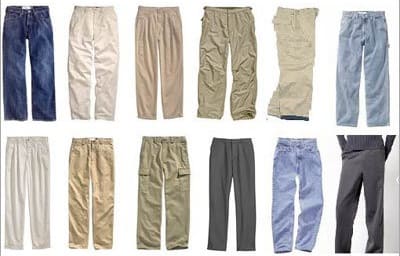When it comes to building a versatile wardrobe, trousers are a staple piece that can enhance your overall style and comfort. Whether you’re dressing for a formal event or a casual outing, selecting the right pair of trousers can make all the difference. In this article, we’ll explore the top 20 tips for choosing trousers that fit well, suit your body type, and align with your fashion goals.
1. Know Your Body Type
The first and most crucial step in choosing the right trousers is understanding your body shape. For instance, slim-fit trousers work well on leaner bodies, while relaxed or straight-leg trousers are better suited for those with more athletic or fuller figures.
2. Choose the Right Rise
The rise of trousers refers to the distance between the waistband and the crotch. There are three primary rises: low-rise, mid-rise, and high-rise. Mid-rise is typically the most flattering for most body types, while high-rise can elongate the legs and low-rise offers a casual, trendy look.
3. Check the Fit
Always prioritize the fit over the brand or design. Trousers that are too tight or too loose can disrupt your silhouette. Ensure there’s enough room in the waist and thigh areas for comfort, but without excess fabric that may look baggy.
4. Pick the Right Fabric
The fabric you choose can impact the comfort and look of your trousers. Cotton, linen, and wool are excellent options depending on the season and occasion. Cotton is breathable and comfortable for casual wear, while wool is more suitable for formal attire.
5. Length Matters
Trousers that are too long or too short can ruin an otherwise great outfit. Ideally, the hem should gently break at the top of your shoes, offering a sharp and well-proportioned look. For a more modern vibe, opt for ankle-length trousers.
6. Consider Your Footwear
Your choice of footwear plays a role in determining the best trousers. Loafers or oxfords pair well with slim or tailored trousers, while boots and sneakers are great for casual or wider-leg options. Always try on trousers with the shoes you plan to wear them with.
7. Look for Stretch
Trousers with a bit of stretch, such as those with elastane or spandex, can offer greater flexibility and comfort, especially if you’re planning to wear them for extended periods.
8. Think About the Occasion
The occasion should guide your choice. Formal events often call for tailored trousers or dress pants, while chinos or cargo pants are ideal for casual outings. Have a variety of styles in your wardrobe to suit different events.
9. Experiment with Colors
While black, navy, and gray are versatile and classic colors, don’t be afraid to experiment with lighter or bolder shades such as beige, burgundy, or even pastel tones. Just make sure the colors complement your skin tone and wardrobe.
10. Pay Attention to Pockets
The type and placement of pockets can make or break the look of your trousers. Slim or hidden pockets tend to be more flattering on dress trousers, while larger, more visible pockets are typical for casual wear like cargo pants.
11. Check for Tapering
Tapered trousers that narrow slightly from the knee to the ankle are universally flattering. They offer a modern, streamlined silhouette without being too restrictive.
12. Invest in Tailoring
Even if a pair of trousers feels right, professional tailoring can make them look exceptional. Having trousers adjusted for length or waist size ensures a perfect fit and enhances your overall appearance.
13. Mind the Waistband
A well-fitting waistband should sit comfortably on your waist without causing discomfort or requiring a belt to stay in place. Avoid overly tight waistbands, as they can create unsightly bulges, while too loose ones can look sloppy.
14. Don’t Forget About Pleats
Pleated trousers offer extra room around the waist and hips, making them ideal for those with fuller thighs. However, flat-front trousers give a sleeker, more modern look and are generally more versatile.
15. Explore Patterns and Prints
Solid colors are a safe bet, but patterned trousers can add personality to your wardrobe. Stripes, plaids, or subtle checks are stylish and can elevate a basic outfit, especially for semi-formal occasions.
16. High-Quality Zippers and Fastenings
Inspect the quality of zippers, buttons, and other fastenings. Poor-quality hardware can ruin the look and longevity of trousers, making them prone to wear and tear.
17. Choose Seasonally Appropriate Materials
Heavier fabrics like wool or tweed are better for winter, providing warmth and structure. In contrast, lighter materials like linen or cotton are breathable and perfect for spring and summer.
18. Balance Comfort and Style
Comfort should never be sacrificed for style, especially when choosing trousers for long periods of wear. Look for trousers that strike a balance between aesthetics and functionality, offering enough movement without compromising the overall look.
19. Watch Out for Wrinkling
Some fabrics, like linen, are more prone to wrinkling. If you’re looking for trousers that maintain their sleek appearance throughout the day, opt for fabrics that resist wrinkles or are easy to care for, such as cotton blends or performance fabrics.
20. Stay True to Your Style
Finally, always select trousers that reflect your personal style. Don’t feel pressured to follow trends if they don’t suit your taste. Classic, well-fitting trousers will always serve as a reliable foundation for a stylish wardrobe.
Conclusion
Finding the perfect trousers doesn’t have to be a daunting task. By focusing on fit, fabric, and function, you can create a well-rounded collection of trousers that suits your body type, lifestyle, and fashion sense. Keep these 20 tips in mind the next time you shop for trousers, and you’ll be sure to find pairs that not only look great but also feel amazing.









